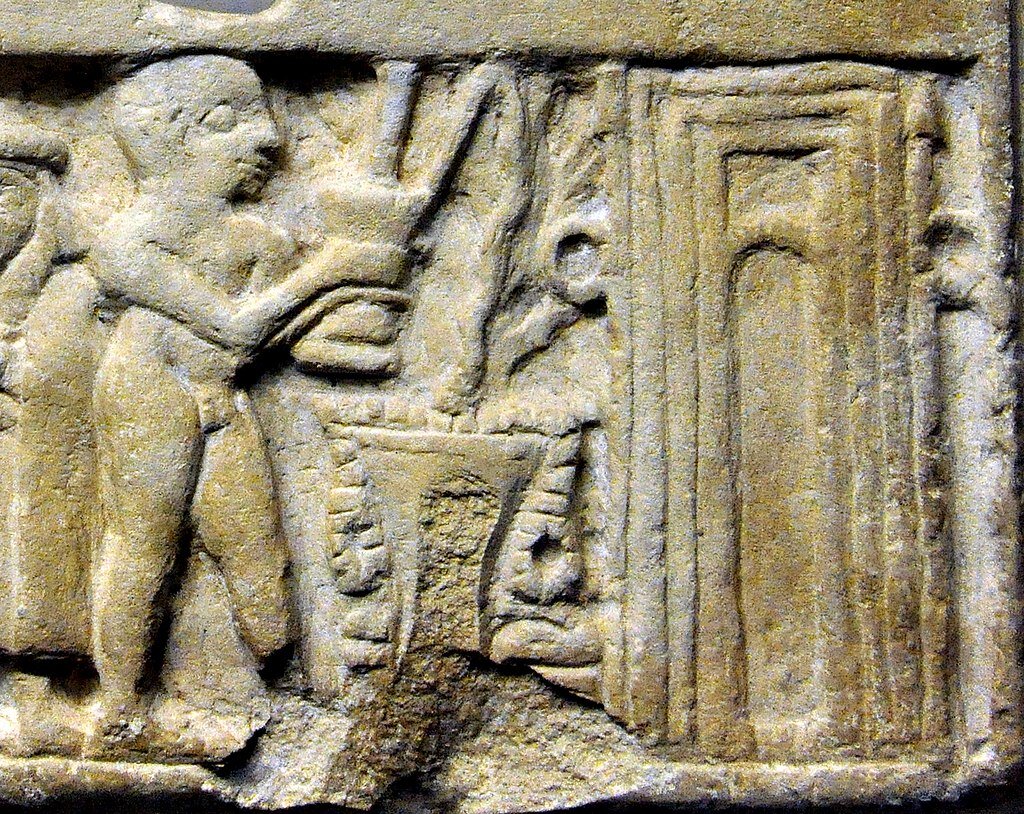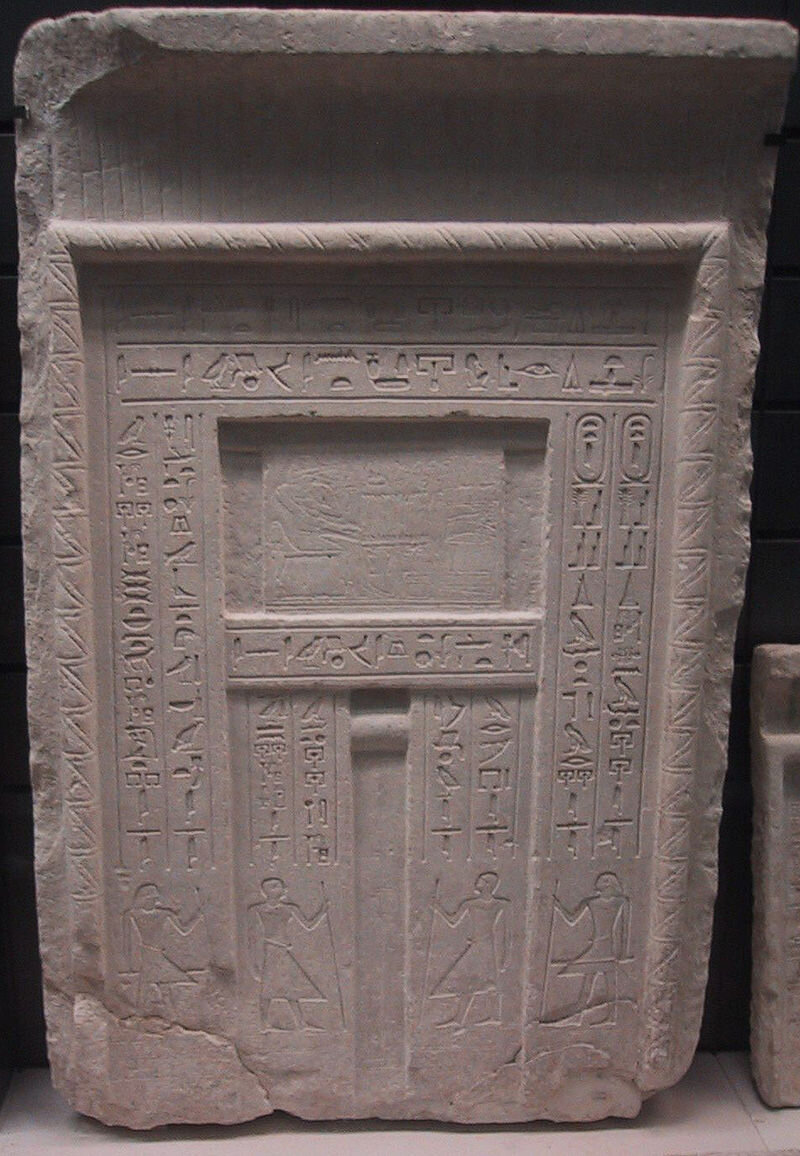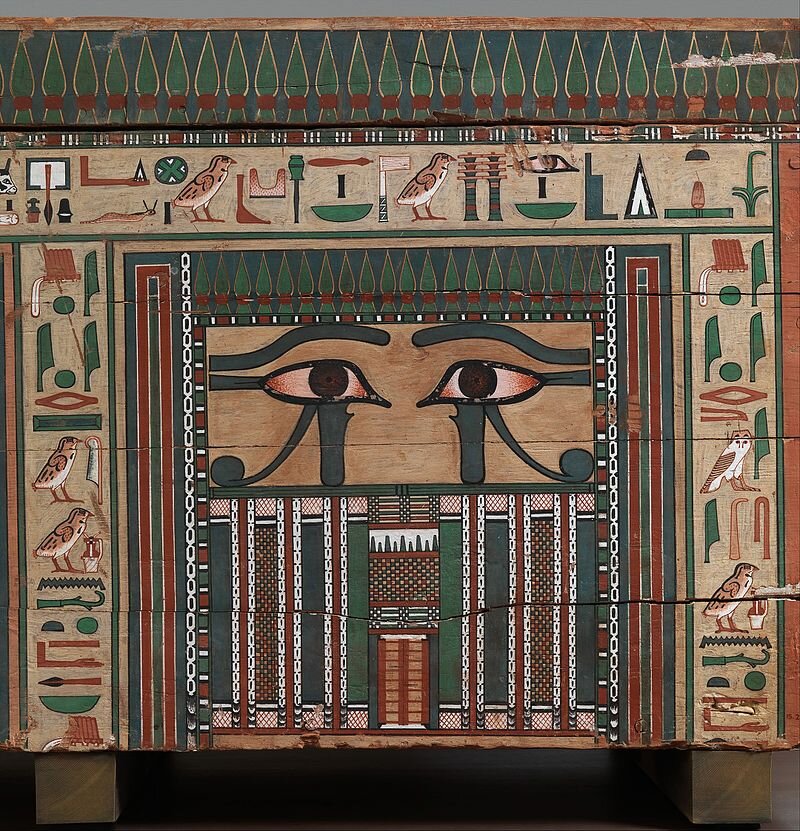 A false door, or recessed niche, is an artistic representation of a door which does not function like a real door. They can be carved in a wall or painted on it. They are a common architectural element in the tombs of ancient Egypt, but appeared possibly earlier in some Pre-Nuragic Sardinian tombs. Later they also occur in Etruscan tombs and in the time of ancient Rome they were used in the interiors of both houses and tombs.
A false door, or recessed niche, is an artistic representation of a door which does not function like a real door. They can be carved in a wall or painted on it. They are a common architectural element in the tombs of ancient Egypt, but appeared possibly earlier in some Pre-Nuragic Sardinian tombs. Later they also occur in Etruscan tombs and in the time of ancient Rome they were used in the interiors of both houses and tombs.
Mesopotamian origin
Egyptian architecture was influenced by Mesopotamian precedents, as it adopted elements of Mesopotamian Temple and civic architecture. These exchanges were part of Egypt-Mesopotamia relations since the 4th millennium BC.

Naked devotee offering libations to a temple of Inanna, c. 2500 BCE. Ur, Mesopotamia.
Recessed niches were characteristic of Mesopotamian Temple architecture, and were adopted in Egyptian architecture, especially for the design of false doors in Mastaba tombs, during the First Dynasty and the Second Dynasty, from the time of the Naqada III period (circa 3000 BC). It is unknown if the transfer of this design was the result of Mesopotamian workmen in Egypt, or if temple designs appearing on imported Mesopotamian seals may have been a sufficient source of inspiration for Egyptian architects.
Ancient Egypt
The ancient Egyptians believed that the false door was a threshold between the worlds of the living and the dead and through which a deity or the spirit of the deceased could enter and exit.
The false door was usually the focus of a tomb’s offering chapel, where family members could place offerings for the deceased on a special offering slab placed in front of the door.
Most false doors are found on the west wall of a funerary chapel or offering chamber because the Ancient Egyptians associated the west with the land of the dead. In many mastabas, both husband and wife buried within have their own false door.

A typical false door to an Egyptian tomb. The deceased is shown above the central niche in front of a table of offerings, and inscriptions listing offerings for the deceased are carved along the side panels.
Structure
A false door usually is carved from a single block of stone or plank of wood, and it was not meant to function as a normal door. Located in the center of the door is a flat panel, or niche, around which several pairs of door jambs are arranged—some convey the illusion of depth and a series of frames, a foyer, or a passageway. A semi-cylindrical drum, carved directly above the central panel, was used in imitation of the reed-mat that was used to close real doors.
The door is framed with a series of moldings and lintels as well, and an offering scene depicting the deceased in front of a table of offerings usually is carved above the center of the door. Sometimes, the owners of the tomb had statues carved in their image placed into the central niche of the false door.
Historical development
The configuration of the false door, with its nested series of doorjambs, is derived from the niched palace façade and its related slab stela, which became a common architectural motif in the early Dynastic period. The false door was used first in the mastabas of the Third Dynasty of the Old Kingdom (c. 27th century BC) and its use became nearly universal in tombs of the fourth through sixth dynasties. During the nearly one hundred and fifty years spanning the reigns of the sixth Dynasty pharaohs Pepi I, Merenre, and Pepi II, the false door motif went through a sequential series of changes affecting the layout of the panels, allowing historians to date tombs based on which style of false door was used.
After the First Intermediate Period, the popularity of the false doors diminished, being replaced by stelae as the primary surfaces for writing funerary inscriptions.
Representations of false doors also appeared on Middle Kingdom coffins such as the Coffin of Nakhtkhnum (MET 15.2.2a, b) dating to late Dynasty 12 (ca. 1850–1750 BC). Here, the false door is represented by two wooden doors that are secured with door bolts, bracketed on both sides by architectural niching – recalling earlier niched temple and palace façades such as the enclosure wall that surrounds the mortuary complex of king Djoser of the Third Dynasty. In a similar manner to the Old Kingdom false doors, representations of false doors on Middle Kingdom coffins facilitated the movement of the deceased’s spirit between the afterlife and the world of the living.

Left-hand side of the Coffin of Nakhtkhnum showing the Middle Kingdom equivalent of the Old Kingdom False Door..
Inscriptions
The side panels usually are covered in inscriptions naming the deceased along with their titles, and a series of standardized offering formulas. These texts extol the virtues of the deceased and express positive wishes for the afterlife.
For example, the false door of Ankhires reads:
The scribe of the house of the god’s documents, the stolist of Anubis, follower of the great one, follower of Tjentet, Ankhires.
The lintel reads:
His eldest son it was, the lector priest Medunefer, who made this for him.
The left and right outer jambs read:
An offering which the king and which Anubis,
who dwells in the divine tent-shrine, give for burial in the west,
having grown old most perfectly.His eldest son it was, the lector priest Medunefer,
who acted on his behalf when he was buried in the necropolis.
The scribe of the house of the god’s documents, Ankhires.